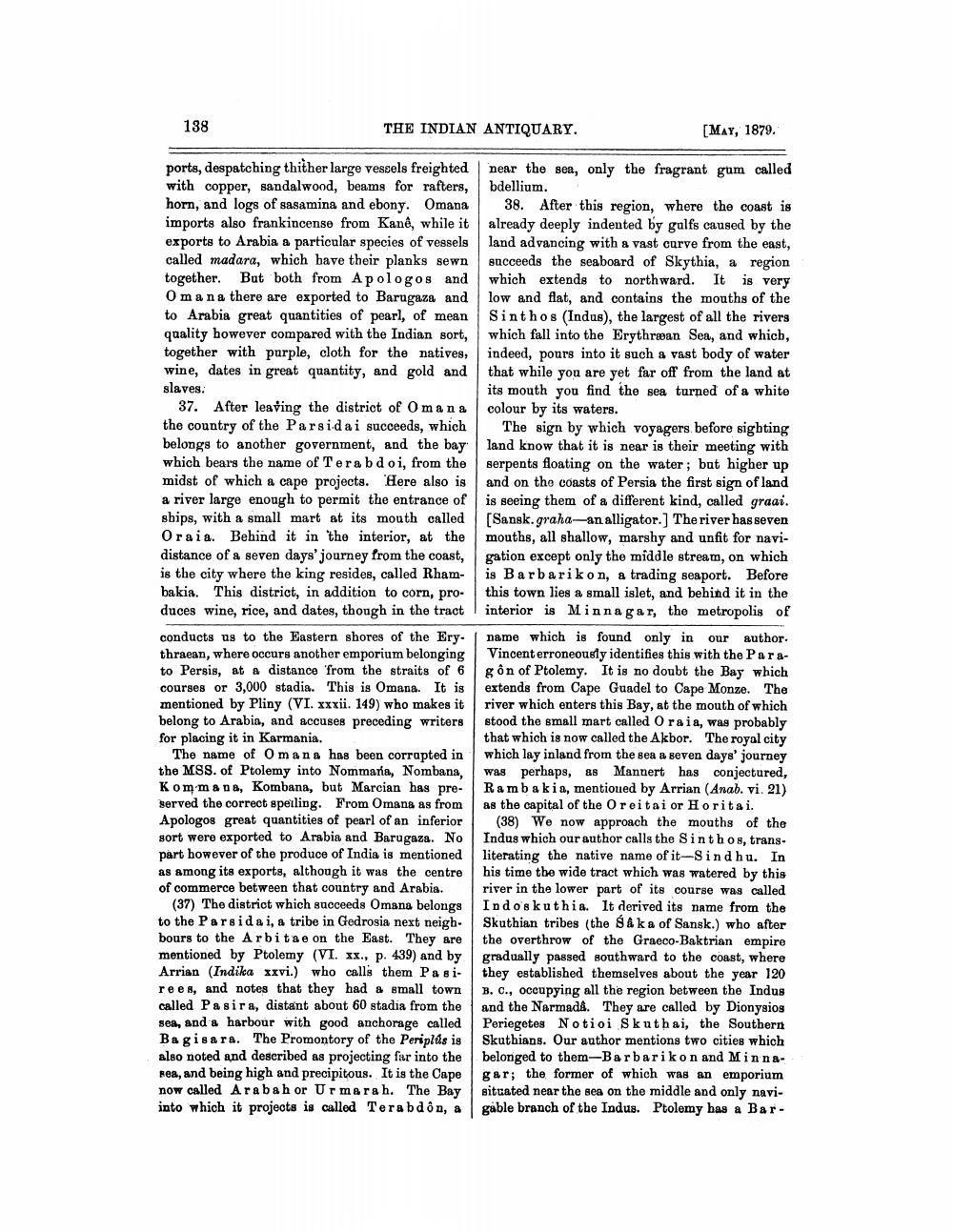________________
138
THE INDIAN ANTIQUARY.
[MAY, 1879.
ports, despatching thither large vessels freighted near the sea, only the fragrant gum called with copper, sandalwood, beams for rafters, bdellium. horn, and logs of sasamina and ebony. Omana 38. After this region, where the coast is imports also frankincense from Kanê, while it already deeply indented by galfs caused by the exports to Arabia a particular species of vessels land advancing with a vast curve from the east, called madara, which have their planks sewn succeeds the seaboard of Skythia, a region together. But both from Apologos and which extends to northward. It is very Omana there are exported to Barugaza and low and flat, and contains the mouths of the to Arabia great quantities of pearl, of mean Sinthos (Indus), the largest of all the rivers quality however compared with the Indian sort, which fall into the Erythræan Sea, and which, together with purple, cloth for the natives, indeed, pours into it such a vast body of water wine, dates in great quantity, and gold and that while you are yet far off from the land at slaves.
its mouth you find the sea turned of a white 37. After leaving the district of Omana colour by its waters. the country of the Parsida i succeeds, which the sign by which voyagers before sigbting belongs to another government, and the bay land know that it is near is their meeting with which bears the name of Terabdoi, from the serpents floating on the water; but higher up midst of which a cape projects. Here also is and on the coasts of Persia the first sign of land a river large enough to permit the entrance of is seeing them of a different kind, called graai. ships, with a small mart at its mouth called [Sansk.graha—an alligator.] The river has seven Oraia. Behind it in the interior, at the mouths, all shallow, marshy and unfit for navidistance of a seven days' journey from the coast, gation except only the middle stream, on which is the city where the king resides, called Rham- is Barbarikon, a trading seaport. Before bakia. This district, in addition to corn, pro- this town lies a small islet, and behind it in the duces wine, rice, and dates, though in the tract 1 interior is Minnagar, the metropolis of conducts us to the Eastern shores of the Ery. name which is found only in our author. thraean, where occurs another emporium belonging Vincent erroneously identifies this with the Parato Persis, at a distance from the straits of 6 g Ôn of Ptolemy. It is no doubt the Bay which courses or 3,000 stadia. This is Omana. It is extends from Cape Guadel to Cape Monze. The mentioned by Pliny (VI. xxxii. 149) who makes it river which enters this Bay, at the mouth of which belong to Arabia, and accuses preceding writers stood the small mart called O raia, was probably for placing it in Karmania.
that which is now called the Akbor. The royal city The name of Omana has been corrapted in which lay inland from the sea a seven days' journey the MSS. of Ptolemy into Nommaria, Nombana, was perhaps, as Mannert has conjectured, Kommand, Kombana, but Marcian has pre- Ramba kia, mentioned by Arrian (Anab. vi. 21) served the correct speiling. From Omana as from as the capital of the Oreitai or Horitai. Apologos great quantities of pearl of an inferior (38) We now approach the mouths of the sort were exported to Arabia and Barugaza. No Indus which our author calls the Sinthog, transpart however of the produce of India is mentioned literating the native name of it--Sindhu. In as among its exports, although it was the centre his time the wide tract which was watered by this of commerce between that country and Arabia river in the lower part of its course was called
(37) The district which succeeds Omana belongs Indo's kuthia. It derived its name from the to the Parsidai, a tribe in Gedrosia next neigh. Skuthian tribes (the & ka of Sansk.) who after bours to the Arbitae on the East. They are the overthrow of the Graeco-Baktrian empire mentioned by Ptolemy (VI. xx., p. 439) and by gradually passed southward to the coast, where Arrian (Indika xxvi.) who calls them Pasi- they established themselves about the year 120 rees, and notes that they had a small town B. C., occupying all the region between the Indus called Pasira, distant about 60 stadia from the and the Narmad. They are called by Dionysios sea, and a harbour with good anchorage called Periegetes Notioi Skuthai, the Southern Ba gisa ra. The Promontory of the Periplus is Skuthians. Our author mentions two cities which also noted and described as projecting for into the belonged to them-Barbarikon and Minnarea, and being high and precipitous. It is the Cape gar; the former of which was an emporium now called Araba h or Urmarah. The Bay situated near the sea on the middle and only naviinto which it projects is called Terabdôn, a gable branch of the Indus. Ptolemy has a Bar




